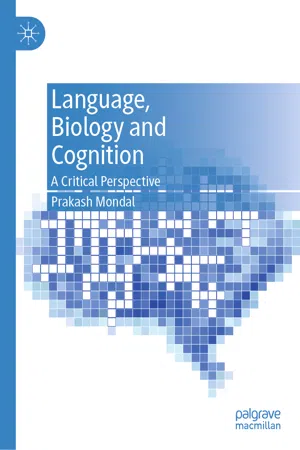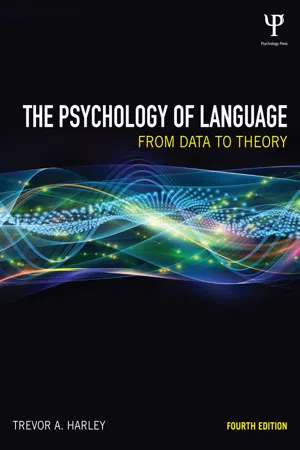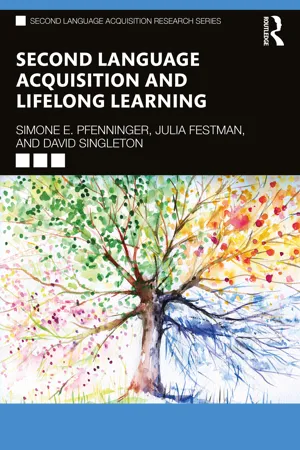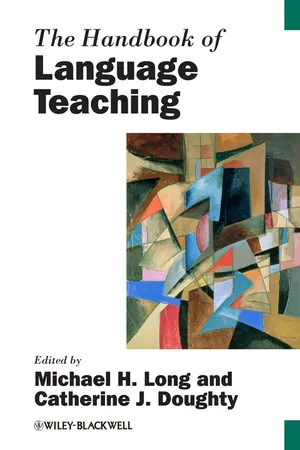Languages & Linguistics
Lenneberg
Lenneberg, in the field of linguistics, is known for his critical period hypothesis, which suggests that there is a specific window of time during childhood when language acquisition must occur in order for a person to achieve native-like fluency. This hypothesis has had a significant impact on the study of language acquisition and the understanding of the relationship between age and language learning.
Written by Perlego with AI-assistance
Related key terms
6 Key excerpts on "Lenneberg"
- María del Pilar García Mayo, María Luisa García Lecumberri(Authors)
- 2003(Publication Date)
- Multilingual Matters(Publisher)
Penfield's notion about the 'unphysiological' nature of later language learning was very much echoed in the work of Lenneberg, the person who is generally acknowledged as the 'father' of the Critical Period Hypothesis relative to language acquisition. Lenneberg saw the human capacity for language acquisition as constrained by a critical period beginning at age two and ending around puberty, this period coinciding with the lateralization process – the specialisation of the dominant hemisphere of the brain for language functions. He adduced a wide range of evidence pointing to changes in the brain that were occurring during this period. However, his claim that lateralisation ends at puberty has been significantly undermined by later studies which reinterpret the data in question as indicating that the process is already complete in early childhood (see, e.g., Kinsbourne & Hiscock, 1977; Krashen, 1973). Moreover, that part of Lenneberg's argument which referred to L2 learning, namely his suggestion that after puberty the learning of L2s required 'labored effort' and foreign accents could not be 'overcome easily' (Lenneberg, 1967: 176) was of dubious status in scientific terms. While his arguments in relation to the maturation of the brain development were supported with a range of neurological evidence (some of which has, as has been noted, since been reinterpreted), no evidence was offered in respect of his claims regarding post-pubertal L2 learning, which relied instead simply on an implicit appeal to popular assumptions.The Concept of Critical Period
Before we proceed further in our discussion of the Critical Period Hypothesis (henceforth CPH), it may be worth reminding ourselves how the concept of critical period is usually understood in the biological sciences. The example that is usually cited in this connection is that provided by Lorenz (1958), who noted that new-born goslings became irreversibly attached to the first moving object they perceived after hatching. Usually, the first moving object in question is the gosling's mother. However, any other moving object will trigger the relevant reaction if it comes into the gosling's line of vision in the post-hatching period. The period during which the attachment of this kind may be effected is limited in duration, and beyond that period the gosling will no longer fix its following behaviour in the way described. Indeed, when this particular period ends, goslings will retreat from rather than follow moving objects.- eBook - ePub
Language, Biology and Cognition
A Critical Perspective
- Prakash Mondal(Author)
- 2019(Publication Date)
- Palgrave Macmillan(Publisher)
1994 ). Although this seems to point to a clear-cut case of a genetic envelope that constrains and limits the time frame within which one can acquire language, this idea has not gone without criticisms.First of all, the constraining effect of the supposed critical period for language acquisition is not an all-or-nothing affair. In many cases, the critical period in itself seems to offer leeway to embrace the effects of other factors (biological or non-biological) that may counterbalance the time constraints of biological maturation. It has turned out that in language acquisition processes, certain components of language are more than constrained by the time frame of biological maturation, while certain other components are less constrained by such limits as those posed by the critical period . For example, learning semantics and vocabulary is less sensitive to the limits posed by the critical period , whereas learning syntax and even structured domains of sound systems which constitute the formal domain of linguistic rules and principles appears to be under a tighter genetic control (Newport et al. 2001 ; Friedmann and Rusou 2015 ). The caveat is that this does not, of course, say much about the biological mechanisms that underlie this relative determination of the learning of various components of language by the critical period . Beyond that, it is not also reasonable to think that the temporal window set by the critical period acts as a switch that is turned off as soon as one reaches a certain age range; rather, it often acts a valve that shows characteristics of sporadic opening and blocking (Herschensohn 2007 ). Besides, even though the language learning ability, especially for syntax, may be said to gradually decline after adolescence, the very existence of the critical period for language learning ability could be due to various factors having to do with culture (major life transitions in social life during and after adolescence) or interference from the first language or neuronal changes due to learning, or a combination of these factors (Hartshorne et al. 2018 - eBook - ePub
The Psychology of Language
From Data to Theory
- Trevor A. Harley(Author)
- 2013(Publication Date)
- Psychology Press(Publisher)
The critical period hypothesis of Lenneberg (1967) comprises two related ideas. The first idea is that certain biological events related to language development can only happen in an early critical period. In particular, hemispheric specialization takes place during the critical period, and during this time children possess a degree of flexibility that is lost when the critical period ends. The second component of the critical period hypothesis is that certain linguistic events must happen to the child during this period for development to proceed normally. Proponents of this hypothesis argue that language is acquired most efficiently during the critical period. The idea of a critical period for the development of particular processes is not unique to humans. Songbirds display hemispheric specialization in that only one hemisphere controls singing (Demers, 1988). Many birds such as the chaffinch are born with the rudiments of a song, but must be exposed to the male song of their species between the ages of 10 and 15 days in order to acquire it normally. Evidence for a critical period for human linguistic development comes from many sources. Many songbirds, such as the chaffinch, are born with the rudiments of a song, but must be exposed to the male song of their species between the ages of 10 and 15 days in order to acquire it normally. Evidence from the development of lateralization The structure of the brain is not completely fixed at birth. A considerable amount of development continues after birth and throughout childhood (and indeed perhaps in adolescence); this process of development is called maturation. Furthermore, the brain (primarily the cortex) shows some degree of plasticity, in the sense that after damage it can to some extent recover and reorganize, or can adapt in response to pronounced changes in input, even in adulthood - Simone E. Pfenninger, Julia Festman, David Singleton(Authors)
- 2023(Publication Date)
- Routledge(Publisher)
Herschensohn (2013) , for example, is very straightforward in what she has to say about its evidential base, stating baldly that the empirical evidence shows “no strictly delimited biological period (definitive onset, offset and terminus) for acquisition of L2 grammar (phonology, morphosyntax, semantics)” (p. 320).6.1.2 Neurolinguists following in the footsteps of Penfield and Lenneberg
If there is a critical period for language in humans, what might be its termini and what might be the extent of its effects? With regard to temporal limits, as Aram et al. (1997) noted 25 years ago, “the end of the critical period for language in humans has proven […] difficult to find, with estimates ranging from 1 year of age to adolescence” (p. 85). Differences concerning the end of such a critical language readiness in fact go back to the very origins of the CPH.For Penfield (Penfield & Roberts, 1959 ), who is widely acknowledged as the forerunner of the CPH, the critical age was 9 years, when the brain was supposed to lose its plasticity i.e. when “for the purposes of learning languages, the human brain becomes increasingly stiff and rigid” (Penfield & Roberts, 1959, p. 236 ). Penfield’s notion that brain plasticity was strictly constrained in age terms is at odds with the current view, which is that the brain remains plastic throughout life, as discussed above (see also Antoniou et al., 2013 ; Gutchess, 2014 ; Ramírez Gómez, 2016 ; Raz & Lindenberger, 2013 ). For Lenneberg (1967) , the so-called “father” of the CPH, on the other hand, the end of the critical age was puberty, when the process of lateralizing language functions to the language-dominant brain-hemisphere was supposed to be complete. This account of lateralization, which from its origins was disputed (see e.g. Krashen, 1973 ), is these days no longer supported by neuroscientists, who favor a complex, multi-factored relationship between lateralization and age (see e.g. Nenert et al., 2017 ).Traditionally, SLA was studied in the context of a single critical period or a series of sensitive periods, each affecting a different linguistic domain (phonology, lexico-semantics, morphology and syntax) and/or different types of features within domains in the development of the human cortex (Uylings, 2006 ). From a brain anatomical point of view, this line of research suggests that certain language skills can only be acquired during a limited critical phase of development. This developmental phase was so far mainly investigated using structural magnetic resonance imaging. In particular, studies have demonstrated an increase of gray matter volume prior to adolescence, followed by a decrease during and after adolescence (Giedd et al., 2006 ). These macro brain changes were accompanied by cellular plasticity such as a vast production of axons and synapses before puberty, followed by pruning in later adolescence (Andersen et al., 2000 ). It was argued that the brain remodels during this developmental period, and neural circuits are shaped from an unrestricted possibility to learn toward effective functioning in order to fulfill specific environmental needs (Crews et al., 2007 ). Although the duration and the end of the period are still matters of ongoing discussion (Singleton, 2005 ), the idea is that this peak in cortical development during adolescence (as measured by cortical volume) is correlated with a high capacity to learn a second language (Uylings, 2006- eBook - ePub
- Kristin Denham, Anne Lobeck(Authors)
- 2018(Publication Date)
- Routledge(Publisher)
9 Studying language in the brain PsycholinguisticsAs you read about in earlier chapters, a central question of linguistics is how we acquire knowledge of language as children. A great deal of evidence suggests that humans are born with the capacity to acquire language and are equipped with some inherent knowledge of language, making the complex task of acquiring language relatively easy, regardless of intellectual capacity, circumstances, or the language that one is exposed to. Psycholinguistics, or the psychology of language, encompasses a great many aspects of the study of language. Some claim, as Noam Chomsky himself has (1972), that linguistics itself can be considered a branch of psychology since psychology is the study of the mind and behavior, and the study of language is an important component of understanding the human mind and human behavior. Psycholinguistics is typically understood to include the study of the acquisition of language by children (sometimes known as L1 acquisition); the processing of language at all levels (phonological, morphological, syntactic, and at the discourse level); and the storage and access of words in the lexicon. Experimental methodologies common in psychology, such as eye-tracking, reaction time, and neural imaging, are often used to assess various aspects of language production, processing, and storage.First language acquisitionChild language acquisition provides us with a great deal of evidence for our innate capacity for language. Neuropsychologist Eric Lenneberg compares the acquisition of language to innate abilities in other species, including eyesight in cats and flight in birds. All such behaviors, he argues, share the following characteristics of biological behavior (Lenneberg, 1967): - eBook - ePub
- Michael H. Long, Catherine J. Doughty, Michael H. Long, Catherine J. Doughty(Authors)
- 2011(Publication Date)
- Wiley-Blackwell(Publisher)
Part III Psycholinguistic Underpinnings of Language LearningPassage contains an image
Chapter 5 The Language-Learning Brain
ALAN BERETTAIn second language learning and teaching, there seem to be two principal ways in which neurolinguistics is of interest: as a source of evidence to support a particular approach to SLA, usually via the critical period issue; and as a source of evidence to promote some supposedly “brain-compatible” classroom teaching technique and to dismiss other techniques that fail on this criterion. The latter use of language-brain research is, to say the least, premature. Even the neuroimaging work on the critical period issue appears to entertain higher expectations than can reasonably be sustained in view of the uncontroversial fact that far less complex problems in language-brain research remain to be solved. This chapter attempts to provide a more realistic perspective.In an attempt to anchor debate to reality, the question that first needs to be considered is what the enterprise of neurolinguistics could possibly be. After all, there is nothing obvious about what is meant by grafting linguistics onto neuro. Once this question is confronted, the answer that it yields may serve as a basis for judging what claims are warranted and what expectations might reasonably be entertained with respect to brains and second language teaching and learning.What is Neurolinguistics?
Someone wishing to find out what neurolinguistics is might turn to the Linguistic Society of America’s website (www.lsa.org), as it contains sketches of the various sub-disciplines of linguistics. Here is what it says about neurolinguistics
Index pages curate the most relevant extracts from our library of academic textbooks. They’ve been created using an in-house natural language model (NLM), each adding context and meaning to key research topics.





